To Cusco and Beyond
Cusco Peru Digital Photography, © 2015 SuZan Alexander
This week we are taking a quick airplane ride to the capital of the Incan Empire: Cusco. So, fasten your virtual seatbelts, because we are just beginning quite the “ride” as we explore the Sacred Valley high in the Andes. And, when I say, high in the Andes, I mean going from 280 feet in elevation to 10,800 feet in the time it takes to fly from Lima to Cusco. Since we are “flat landers” living at about 600 feet, we allotted a day to acclimate to the altitude before we started our hiking excursions. First up, the Sacsayhuaman Archaeological Park.
Day 1 of the Sacred Valley:
Sacred Valley I Collage, Digital Photography, © 2015 SuZan Alexander
Tambomachay:
We traveled about 4-5 miles outside Cusco. Our driver let us out and, after an easy walk, we were at our first Inca ruins. Tambomachay is an example of the masonry skills of the Incas. The remaining walls are so precisely cut and fitted together without benefit of mortar, which is amazing in itself, but then when you see the series of fountains still providing water to the site centuries later, you say to yourself... Amazing.
Saqsayhuaman:
We continued our hike where we saw a herder with a flock of sheep and passed by a few adobe homes until we reached Sacsayhuaman. Our guide told us Sacsayhuaman is believed to be a Temple of Lightning. When you get a look at the big picture of the three-layered zig-zag terraces resembling bolts of lightning, it is not hard to imagine how that theory was born. Today, the large plaza is used for the annual Inca Festival of Winter Solstice (Inti Raymi), as well as other festivals. The site is located on a hill above Cusco which provides a perfect view of the valley below.
Qenqo:
Qenqo is located in the east part of the archeological park. There are two large monoliths and is considered one of the larges holy places in the Cusco region. It is believed that perfectly preserved mummies were housed in niches around the perimeter of the site. As you enter a cave in the center of the site, there is a stone slab table that seems to suggest it was a place where sacrifices took place.
Puca Pucara
The construction at the site is impressive, but lacks the precise details that are apparent at the other sites. This indicates that the use of the site was probably more pedestrian. The logical indication would be that of a military base to protect Cusco because it provides great views of the main plaza.
Plaza de Armas Digital Photography, © 2015 SuZan Alexander
The Inca palace was located on what is now called the Plaza de Armas. The palaces in Cusco were converted, or built over, to transform them into churches, monasteries, convents, or homes for the Spaniards, The stones used for the construction of the churches were harvested from the nearby Sacsayhuaman site. Today, the churches are central characters of the Plaza de Armas and keepers of art and history of the region.
San Blas Cathedral:
Church of San Blas is an understated façade that does not hint at the treasures housed within. The real jewel in the proverbial crown is the ornate pulpit carved from a single cedar stump. The artist, Juan Tomás Tuyro Tupaq, carved the pulpit using a drawing as his guide. His creation is something to ponder. He suffered from leprosy and the pain he must have endured to carve this stunning work of art is a visual testament to, not only his artistry, but his devotion. This may be the very definition of “labor of love” in the visible format.
Temple of the Sun:
The Temple of the Sun (Qurikancha) was the site of the great opulent temple in the Inca Empire. The accounts of the gold statues, ornaments, and plates make an interesting read. All of the gold has long since removed and melted down during the Spanish Conquest. It is still a beautiful place to visit full of history.
Cathedral Basilica of the Assumption of the Virgin:
We walked to the Cathedral on the Plaza de Armas. The Cathedral was originally built OVER the Inca temple (Wiracocha) in the 16th and 17th centuries. Interestingly, the Inca temples below the current Cathedral survived earthquakes – the “newer” structures did not fare as well and have been rebuilt. Nevertheless, it is still the centerpiece of the town and is beautiful. Today it houses several works of art attributed to the Cusco School of Art, including the painting of The Last Supper which features a cuy (guinea pig) rather than a lamb because that is what is familiar in the Andes.
Hang in there with me. The hiking gets a little more challenging, and you know I'm going to make you laugh with me. Okay, I'll be honest. You will be laughing AT me not WITH me. Until next week...
Happy trails...













